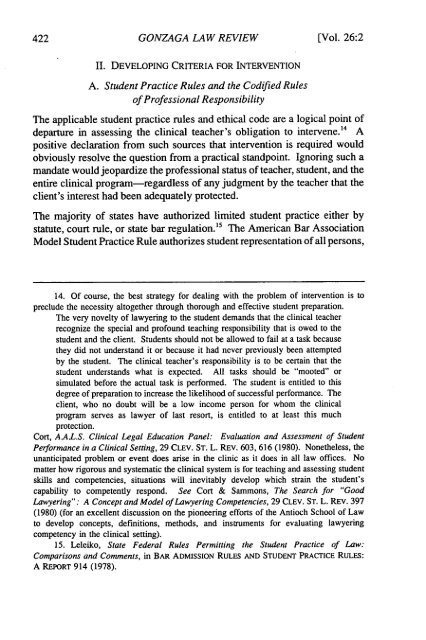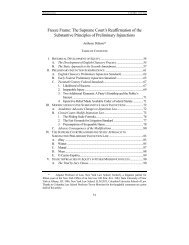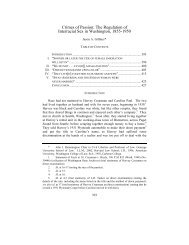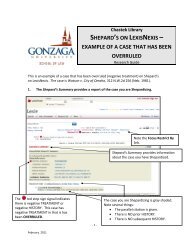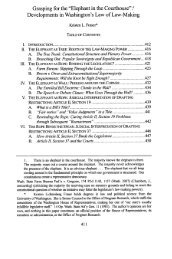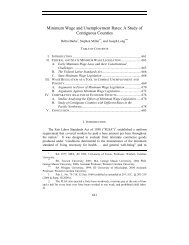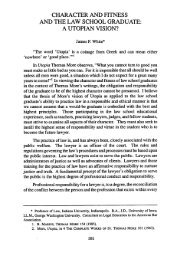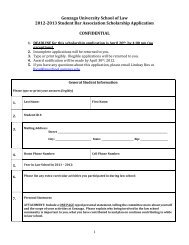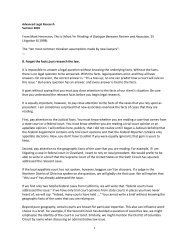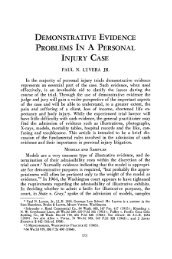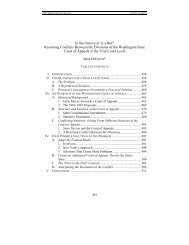professional responsibility, student practice, and the clinical
professional responsibility, student practice, and the clinical
professional responsibility, student practice, and the clinical
You also want an ePaper? Increase the reach of your titles
YUMPU automatically turns print PDFs into web optimized ePapers that Google loves.
GONZAGA LAW REVIEW<br />
[Vol. 26:2<br />
II. DEVELOPING CRITERIA FOR INTERVENTION<br />
A. Student Practice Rules <strong>and</strong> <strong>the</strong> Codified Rules<br />
of Professional Responsibility<br />
The applicable <strong>student</strong> <strong>practice</strong> rules <strong>and</strong> ethical code are a logical point of<br />
departure in assessing <strong>the</strong> <strong>clinical</strong> teacher's obligation to intervene.' 4 A<br />
positive declaration from such sources that intervention is required would<br />
obviously resolve <strong>the</strong> question from a practical st<strong>and</strong>point. Ignoring such a<br />
m<strong>and</strong>ate would jeopardize <strong>the</strong> <strong>professional</strong> status of teacher, <strong>student</strong>, <strong>and</strong> <strong>the</strong><br />
entire <strong>clinical</strong> program-regardless of any judgment by <strong>the</strong> teacher that <strong>the</strong><br />
client's interest had been adequately protected.<br />
The majority of states have authorized limited <strong>student</strong> <strong>practice</strong> ei<strong>the</strong>r by<br />
statute, court rule, or state bar regulation. 5 The American Bar Association<br />
Model Student Practice Rule authorizes <strong>student</strong> representation of all persons,<br />
14. Of course, <strong>the</strong> best strategy for dealing with <strong>the</strong> problem of intervention is to<br />
preclude <strong>the</strong> necessity altoge<strong>the</strong>r through thorough <strong>and</strong> effective <strong>student</strong> preparation.<br />
The very novelty of lawyering to <strong>the</strong> <strong>student</strong> dem<strong>and</strong>s that <strong>the</strong> <strong>clinical</strong> teacher<br />
recognize <strong>the</strong> special <strong>and</strong> profound teaching <strong>responsibility</strong> that is owed to <strong>the</strong><br />
<strong>student</strong> <strong>and</strong> <strong>the</strong> client. Students should not be allowed to fail at a task because<br />
<strong>the</strong>y did not underst<strong>and</strong> it or because it had never previously been attempted<br />
by <strong>the</strong> <strong>student</strong>. The <strong>clinical</strong> teacher's <strong>responsibility</strong> is to be certain that <strong>the</strong><br />
<strong>student</strong> underst<strong>and</strong>s what is expected. All tasks should be "mooted" or<br />
simulated before <strong>the</strong> actual task is performed. The <strong>student</strong> is entitled to this<br />
degree of preparation to increase <strong>the</strong> likelihood of successful performance. The<br />
client, who no doubt will be a low income person for whom <strong>the</strong> <strong>clinical</strong><br />
program serves as lawyer of last resort, is entitled to at least this much<br />
protection.<br />
Cort, A.AL.S. Clinical Legal Education Panel: Evaluation <strong>and</strong> Assessment of Student<br />
Performance in a Clinical Setting, 29 CLEV. ST. L. REV. 603, 616 (1980). None<strong>the</strong>less, <strong>the</strong><br />
unanticipated problem or event does arise in <strong>the</strong> clinic as it does in all law offices. No<br />
matter how rigorous <strong>and</strong> systematic <strong>the</strong> <strong>clinical</strong> system is for teaching <strong>and</strong> assessing <strong>student</strong><br />
skills <strong>and</strong> competencies, situations will inevitably develop which strain <strong>the</strong> <strong>student</strong>'s<br />
capability to competently respond. See Cort & Sammons, The Search for "Good<br />
Lawyering": A Concept <strong>and</strong> Model of Lawyering Competencies, 29 CLEV. ST. L. REv. 397<br />
(1980) (for an excellent discussion on <strong>the</strong> pioneering efforts of <strong>the</strong> Antioch School of Law<br />
to develop concepts, definitions, methods, <strong>and</strong> instruments for evaluating lawyering<br />
competency in <strong>the</strong> <strong>clinical</strong> setting).<br />
15. Leleiko, State Federal Rules Permitting <strong>the</strong> Student Practice of Law:<br />
Comparisons <strong>and</strong> Comments, in BAR ADMISSION RULES AND STUDENT PRACTICE RULES:<br />
A REPORT 914 (1978).


